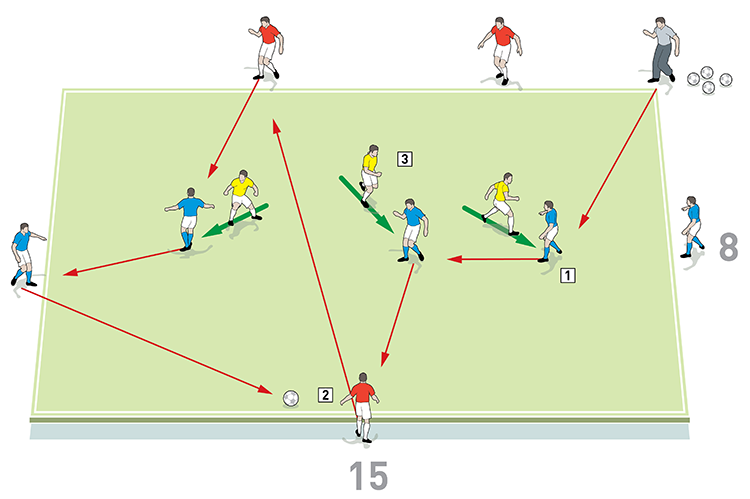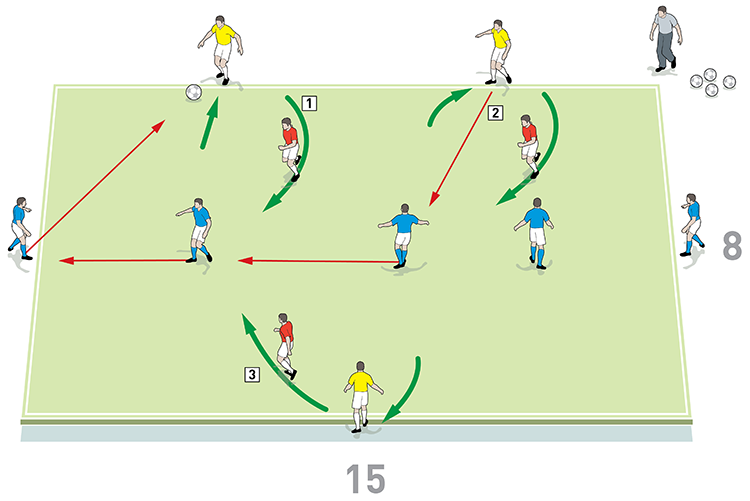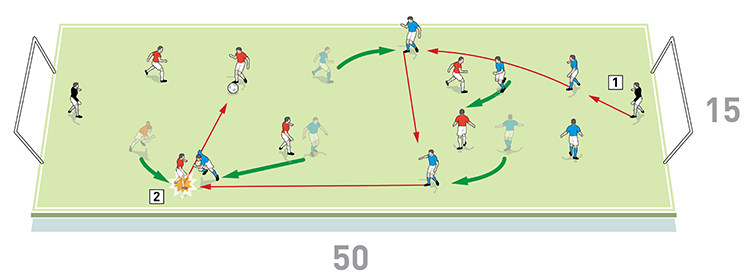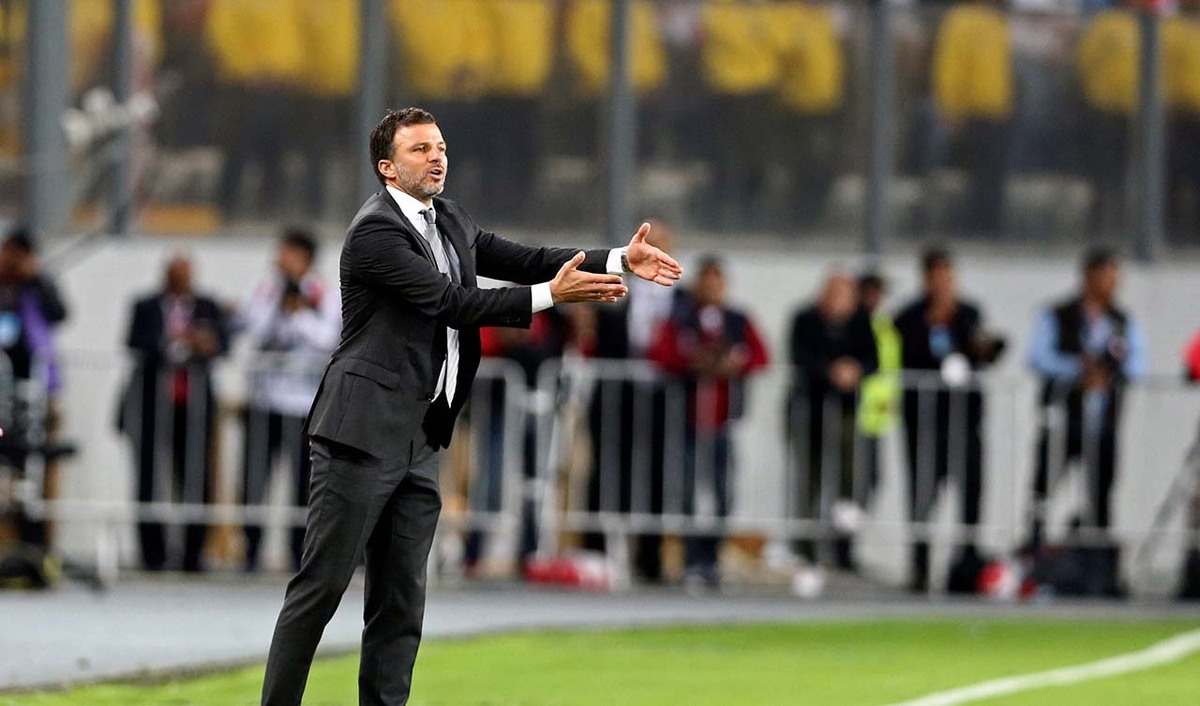




OUR BEST EVER OFFER - SAVE £100/$100
JOIN THE WORLD'S LEADING PROFESSIONAL DEVELOPMENT PROGRAMME
- 12 months membership of Elite Soccer
- Print copy of Elite Player & Coach Development
- Print copy of The Training Ground
Transition from attack to defence
This session is all about working on the transition from attack to defence. Making this quick transition is a critical part of the game and when performed properly in matches, it is a highly effective tactic.
| Area | Up to 50x15 yards |
| Equipment | Balls, bibs, cones, 2 full size goals |
| No. of Players | Up to 12 players + 2 goalkeepers |
| Session Time |
Transition practice: 10mins, Small-sided game: 20mins |
This session is all about working on the transition from attack to defence. Making this quick transition is a critical part of the game and when performed properly in matches, it is a highly effective tactic.
This session encourages an immediate reaction when teams lose possession of the ball and it builds good habits and team cohesion. It’s a challenging and demanding practice and there really is no hiding place for the players.
Ideally, I would run this activity once a week, usually on the hardest session of the week.
What do I get the players to do?
Transition practice
We set up an area of 15x8 yards. We’re using 11 outfield players split into one team of five (the blues) and two teams of three (the reds and the yellows), set up as shown [1a]. The three yellows start in the central area along with three of the blues, who also have one player on each side of the area. Two reds are positioned along one end and their team mate starts at the other end. The blues must keep their shape and hold their line across the playing area for the duration of the game.
1a

2. The blues keep hold of the ball with the help of the three reds outside the area
3. The three yellows press and try to win possession in the central area
Play starts with a pass from the coach into the blue team of five, who must try to keep hold of the ball with the help of the three reds outside the area. They do this under pressure from the three yellows, who press to try to win possession in the central area, as shown [1b]. If they manage to win the ball, they should clear it out of the area and the coach quickly restarts play with another pass to the team of five.
1b

2. The third time the yellows win the ball, as here, the reds should transition from attack to defence and should quickly enter the area to regain possession
On the third turnover of possession, the reds transition into the defending role, immediately going into the area to try to win the ball back. The yellows quickly swap places with the reds on the outside and join with the blues in keeping hold of the ball under pressure, as shown [1c]. We play four games of two minutes each.
1c

2. The yellows now join forces with the blue team of five to keep hold of the ball
3. The reds now press and must try to win the ball three times before becoming attackers again
How would you put this into a game situation?
Small-sided game
We set up a long and narrow playing area of 50x15 yards with a full size goal and goalkeeper at each end. We’re using 12 outfield players split into two teams of six plus keepers.
We play a 6v6 game, as shown [2], and look for the players to make fast transitions from attack to defence when possession of the ball is lost.
2

2. When possession is lost, players should transition quickly from attack to defence
What are the key things to look out for?
We want to see players react immediately when the transition from attack to defence occurs. They should work together and hunt in packs in order to regain possession as quickly as possible.
Communication is vital when defenders put pressure on the ball and they should try to force play in order to cut out opposition attacks.
Related Files
Editor's Picks
Attacking transitions
Deep runs in the final third
Using the goalkeeper in build-up play
Intensive boxes drill with goals
Penetrating the final third
Creating and finishing
My philosophy
Pressing initiation
Compact team movement
Coaches' Testimonials

Alan Pardew

Arsène Wenger

Brendan Rodgers

Carlos Carvalhal

José Mourinho

Jürgen Klopp

Pep Guardiola

Roy Hodgson

Sir Alex Ferguson

Steven Gerrard
Related
Coaches' Testimonials

Gerald Kearney, Downtown Las Vegas Soccer Club

Paul Butler, Florida, USA

Rick Shields, Springboro, USA

Tony Green, Pierrefonds Titans, Quebec, Canada
Join the world's leading coaches and managers and discover for yourself one of the best kept secrets in coaching. No other training tool on the planet is written or read by the calibre of names you’ll find in Elite Soccer.
In a recent survey 92% of subscribers said Elite Soccer makes them more confident, 89% said it makes them a more effective coach and 91% said it makes them more inspired.
Get Monthly Inspiration
All the latest techniques and approaches
Since 2010 Elite Soccer has given subscribers exclusive insight into the training ground practices of the world’s best coaches. Published in partnership with the League Managers Association we have unparalleled access to the leading lights in the English leagues, as well as a host of international managers.
Elite Soccer exclusively features sessions written by the coaches themselves. There are no observed sessions and no sessions “in the style of”, just first-hand advice delivered direct to you from the coach.







